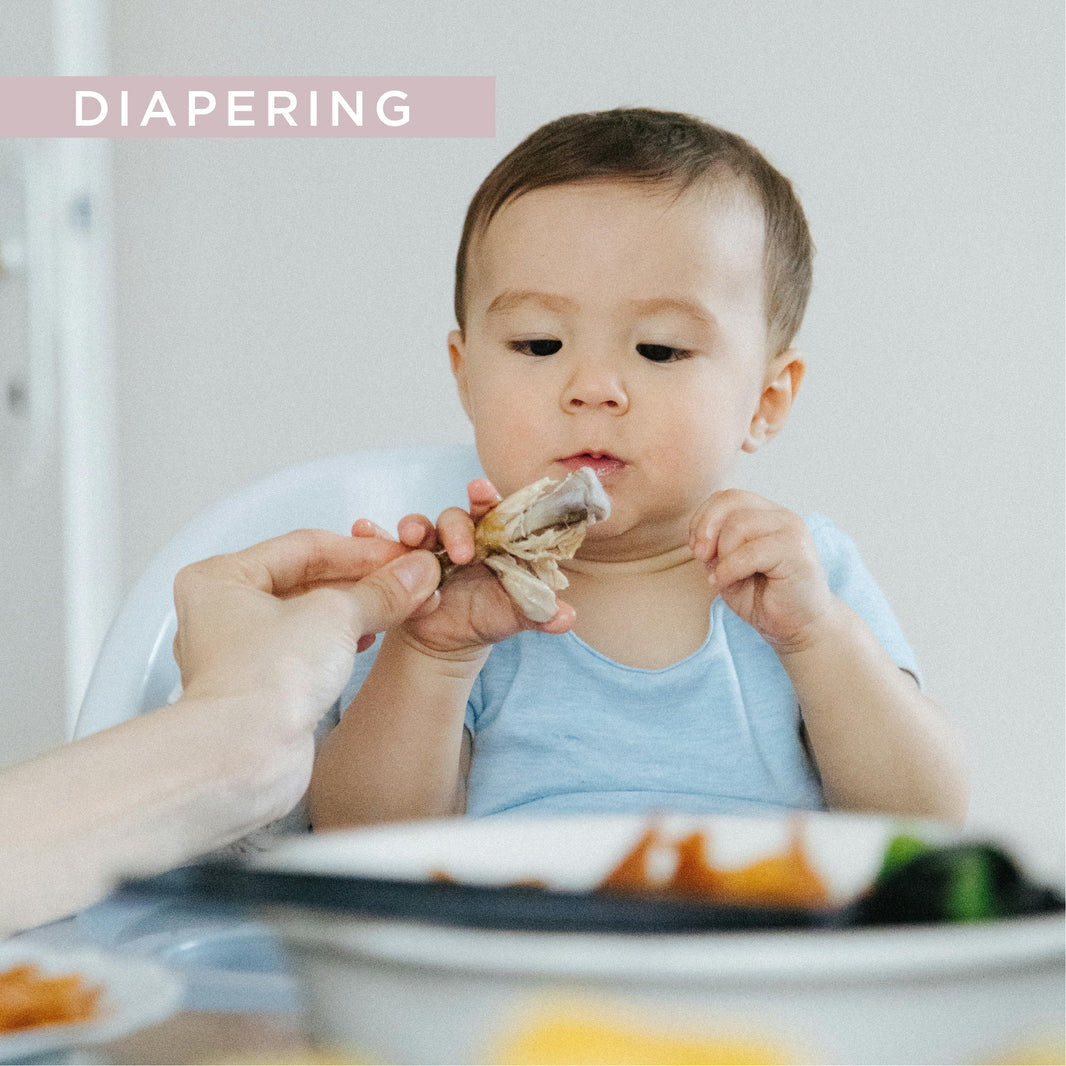Congrats! If you’ve landed here, you’re likely either just getting started or are gearing up for the exciting milestone of introducing solids to your little one! This stage comes with some of the sweetest memories (pun absolutely intended as you experiment with those first bites of fruit 😉🫐), and it also comes with a few new habits when it comes to cloth diapering.
If you’ve been cloth diapering since your baby was on a milk-only diet, you’ve hopefully noticed how simple laundry has been so far! (Need a refresher on this stage? We break it down here.) Once solids enter the mix, though, poop changes – and so does how you handle it. But good news! With a few easy adjustments, you can keep cloth diapering simple, clean, and stress-free. Here’s what you need to know!
Refresher: Do I Need to Remove Poop from Cloth Diapers Before Washing?
Milk-only diet (breastmilk and/or formula): Nope! If your baby is exclusively breastfed or formula-fed, you don’t need to remove poop before laundering. That newborn-stage poop is water-soluble, meaning your washing machine can easily take care of it. Just toss everything into your Pail Pouch and let your wash routine handle the rest.
After solids begin: Yes – once solids are in the mix, poop becomes thicker, stickier, and less water-soluble. At this stage, it’s important to remove the bulk of the poop before putting your diapers aside for laundry. We’ll get into hassle-free tips for how to go about this below!

Formula-Fed vs. Exclusively Breastfed Babies
We often get asked if there’s a difference between formula-fed and breastfed babies when it comes to cloth diaper laundry. So we want to re-emphasize here: in our experience, there isn’t!
As long as your baby is on a milk-only diet (whether breastmilk or formula), poop can be laundered the same way. (Fun fact: before launching Esembly, we ran a busy cloth diaper laundry service, so we’ve explored this thoroughly!) It remains water-soluble and doesn’t require any scraping, rinsing, or spraying. The shift happens not because of formula vs. breastmilk, but because of starting solids. That’s when poop consistency changes and you’ll need to start removing the bulk before laundering.
Why We Don’t Recommend Spraying or Rinsing
You might have read about (or seen) cloth diaper sprayers, dunking, and rinsing routines – especially when solids are introduced! While common, we’re not big fans of these methods for a few reasons:
Mess factor: Spraying often leads to back-splash and poop flecks flying around your bathroom. Rinsing means handling wet, soiled diapers. Not fun.
Mold + mildew risk: Wet diapers sitting in a Pail Pouch create the perfect environment for mold growth.
Fabric damage: Over time, constant rinsing/soaking weakens natural fibers, leading to premature wear and tear.
Instead of rinsing or spraying, we recommend simpler, cleaner options. (feel free to dive deeper into the topic of rinsing and spraying in this blog post if you’re still not convinced!)
Tools of the Trade for Starting Solids

When it comes to starting solids, liners can make life a whole lot easier. Our disposable Tossers are ultra-thin, biodegradable sheets that you simply lay on top of the Inner (aka our organic cotton fitted diapers) before putting the diaper on your baby. They allow moisture to pass through while catching most of the solid mess. At change time, just lift out the soiled Tosser and toss it in the trash – simple and mess-free.
If you’d prefer a reusable option, our Stay-Dry Liners are made from soft fleece that can be washed and used again and again. Because poop doesn’t cling to fleece quite the same way it does to cotton, you can easily shake it into the toilet and then toss the liner in with your diaper laundry. As a bonus, Stay-Dry Liners also wick moisture away from your baby’s skin, keeping them feeling drier between changes.

What If I Forget to Use a Liner?
Don’t stress! Just shake off or wipe off as much of the poop as you can (a little toilet paper or baby wipe works wonders for sticky messes) and drop the diaper straight into your pail. Your washing machine can handle the rest.
Do I Need Liners Forever?
It’s completely up to you! Liners tend to be most helpful during the transition stage, when poop takes on that infamous sticky, peanut-butter-like consistency. Once your baby’s diet shifts to mostly solids, though, poops usually become firmer and much easier to shake off into the toilet – making it simpler to go without liners if you’d prefer.
Bottom Line: Starting Solids with Cloth Diapers is Easy!
Cloth diapering through the solids stage doesn’t have to be overwhelming. With the right tools (and a little perspective), you’ll find your groove quickly. Remember:
Milk-only diet poop = nothing to remove.
Solid food poop = remove the bulk, no rinsing or spraying required.
Liners make life easier (but are totally optional).
And in case you haven’t heard it yet: you’ve got this!! 🙌 Cloth diapering really can be as easy as a few extra loads of laundry each week – even as your baby explores solid foods!






